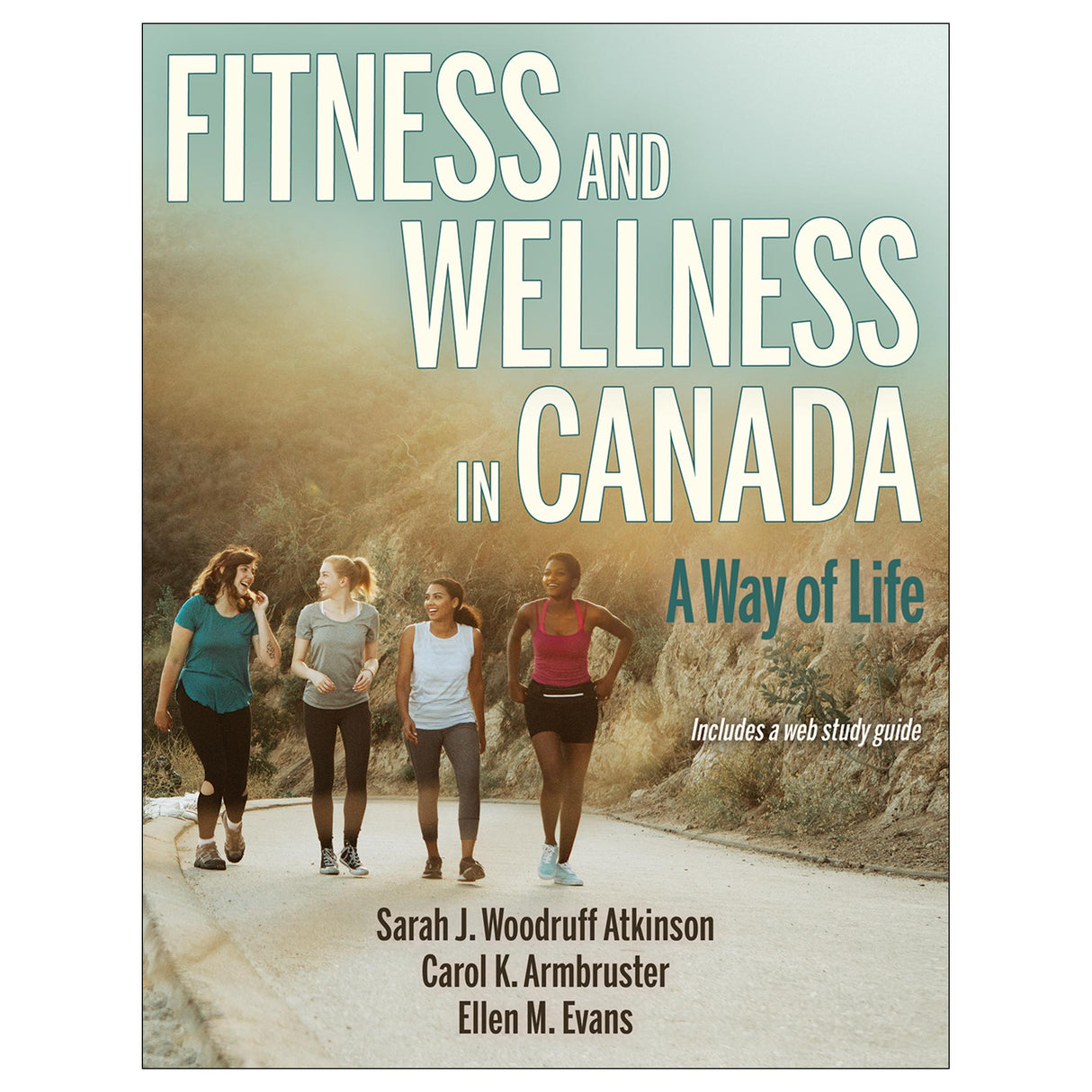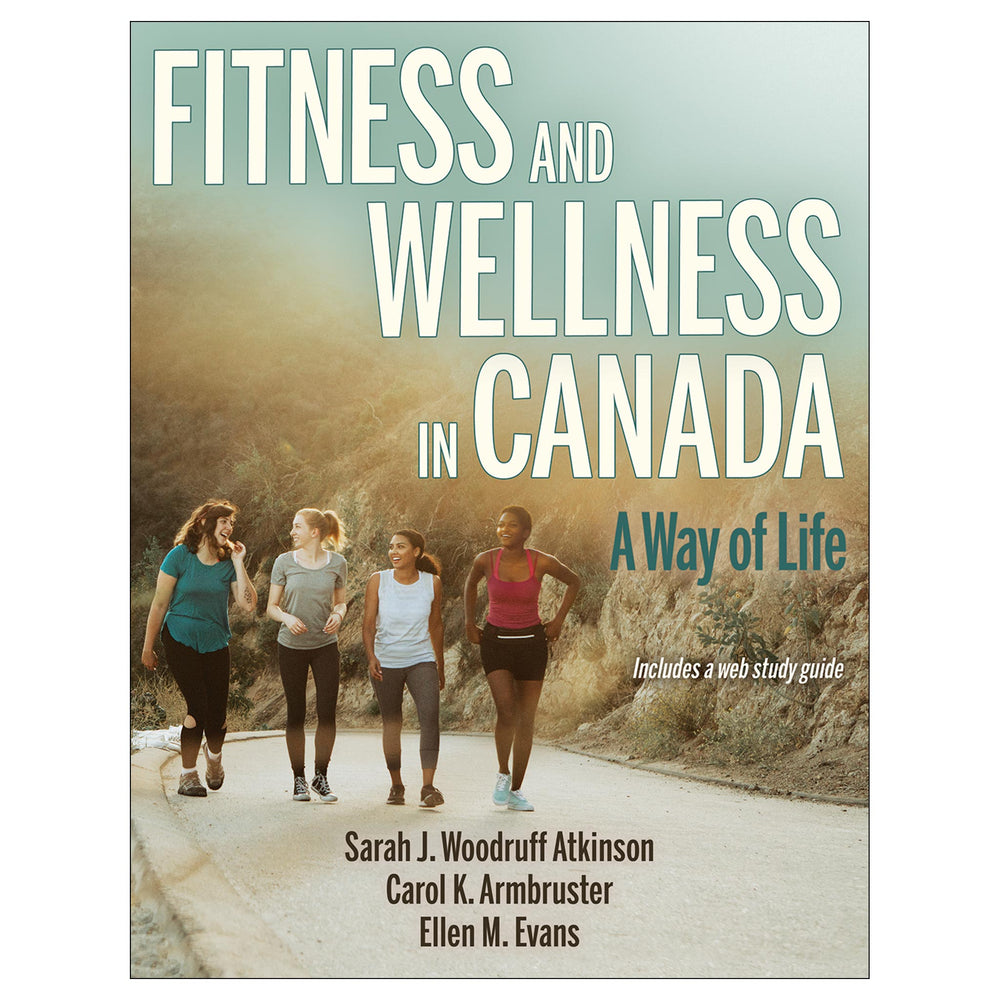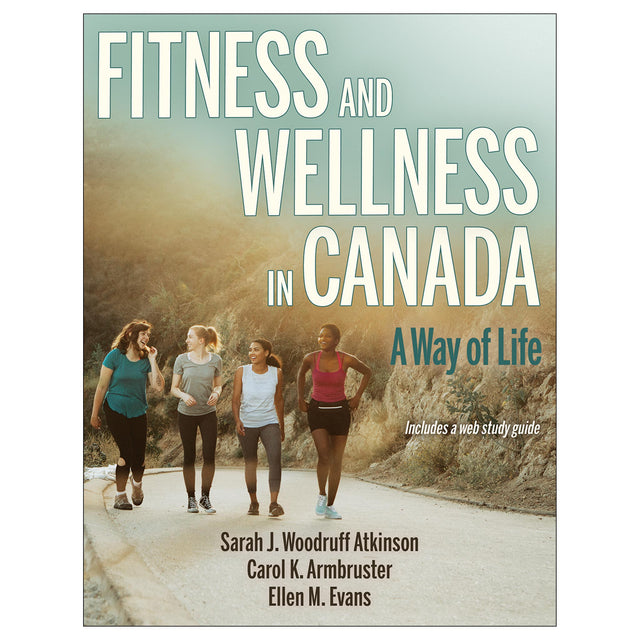Ebook With Online Resource
Fitness and Wellness in Canada epub With Web Study Guide
$99.95 CAD
Unit price
/
Unavailable
Ebook With Online Resource
$99.95 CAD
$99.95 CAD
Access Duration: 10 Years
Ebook With Online Resource
With content targeted specifically toward higher education students in Canada, Fitness and Wellness in Canada: A Way of Life With Web Study Guide presents evidence-based physical and mental health guidance to point students toward healthy choices that will develop into healthy lifestyles.
Authors Sarah J. Woodruff Atkinson, Carol K. Armbruster, and Ellen M. Evans have more than 80 years of combined professional experience in health and wellness, the majority of which has focused on the higher education population. This enables them to present the material in a contemporary manner that is relatable and easily understood by students.
Relevant information on topics such as cardiorespiratory exercise, strength training, stretching, nutrition, weight management, stress management, substance abuse and addiction, and sexual health will start students on the path to developing a healthy mind and body, which can lead to a better quality of life. Additionally, because Fitness and Wellness in Canada: A Way of Life emphasizes behaviour modification to develop desired habits, students are armed with the tools they need to make healthy lifestyle changes—for both the present and future:
In addition, students will benefit from learning aids such as key terms, a glossary, and review questions for each chapter. Instructors will benefit from an abundance of online ancillaries: a presentation package plus image bank, test package, chapter quizzes, and an instructor guide that includes chapter summaries, chapter objectives, class outlines, sample answers to the chapter review questions, and suggested class activities.
The primary goal of Fitness and Wellness in Canada: A Way of Life is to provide evidence-based guidance to help students embrace living well. Students will learn how to make healthy choices and positive behaviour changes to lead healthier, happier, and more productive lives, now and in the future.
Authors Sarah J. Woodruff Atkinson, Carol K. Armbruster, and Ellen M. Evans have more than 80 years of combined professional experience in health and wellness, the majority of which has focused on the higher education population. This enables them to present the material in a contemporary manner that is relatable and easily understood by students.
Relevant information on topics such as cardiorespiratory exercise, strength training, stretching, nutrition, weight management, stress management, substance abuse and addiction, and sexual health will start students on the path to developing a healthy mind and body, which can lead to a better quality of life. Additionally, because Fitness and Wellness in Canada: A Way of Life emphasizes behaviour modification to develop desired habits, students are armed with the tools they need to make healthy lifestyle changes—for both the present and future:
- A web study guide offers more than 50 video clips and practical learning activities to provide real-life context for the material.
- Behaviour Check sidebars help students integrate health and wellness concepts into their daily lives.
- Now and Later sidebars encourage students to consider how their actions today will affect them in the future.
- The Functional Movement Training section shows exercises to strengthen specific muscles and explains their importance for everyday activities.
- Infographics, research-based tables, and figures illustrate and reinforce key concepts so they are easy to understand.
- Canada’s Food Guide is included to assist students in making healthy nutritional choices.
In addition, students will benefit from learning aids such as key terms, a glossary, and review questions for each chapter. Instructors will benefit from an abundance of online ancillaries: a presentation package plus image bank, test package, chapter quizzes, and an instructor guide that includes chapter summaries, chapter objectives, class outlines, sample answers to the chapter review questions, and suggested class activities.
The primary goal of Fitness and Wellness in Canada: A Way of Life is to provide evidence-based guidance to help students embrace living well. Students will learn how to make healthy choices and positive behaviour changes to lead healthier, happier, and more productive lives, now and in the future.
Audience
Primary textbook for undergraduate courses related to lifelong wellness, health, lifestyle management, and physical fitness. Chapter 1. Staying Healthy and Well Throughout Life
Staying Healthy Through the Life Span
New Perspectives on Wellness
Components of Wellness
What Are Functional Movement and Wellness?
Summary
Chapter 2. Functional Fitness and Movement Choices
Understanding Physical Activity Recommendations
Integrating Sedentarism, Physical Activity, and Exercise
Fitting Movement Into Everyday Life
Summary
Chapter 3. Successfully Managing Healthy Behaviour Change
Are You Ready to Change?
Personalizing the Behaviour Change Process
Goal Setting Revisited
Safety First: Getting Started With a Personal Movement Program
Summary
Chapter 4. Cardiorespiratory Fitness
Your Energy Needs: Supply and Demand
Evaluating Your Cardiorespiratory Function
Cardiorespiratory Fitness Benefits You
Your Plan to Improve Cardiorespiratory Fitness
Safety First: Getting Started With Cardiorespiratory Fitness
Summary
Chapter 5. Muscular Fitness
Your Body Was Designed to Move
Key Definitions
Assessing Muscle Capacity
Muscular Fitness Benefits Your Daily Life
Designing Your Program for Muscular Fitness
Analyzing Your Fitness Choices
Safety Issues
Summary
Chapter 6. Flexibility, Neuromotor Fitness, and Posture
All About Flexibility
Mind the Stretch Reflex!
Neuromotor Exercise and Functional Fitness
Physiological Teamwork for Flexibility and Neuromotor Fitness
Preventing Low Back Pain
Summary
Functional Movement Training
Calves
Quads
Hams and Glutes
Abdominals
Lower Back
Hip Abductors
Hip Adductors
Chest and Front of Shoulder
Upper Back and Shoulders
Lats and Middle Back
Front of Upper Arm
Back of Upper Arm
Chapter 7. Body Composition
Body Composition Basics
Assessing Body Composition
Weight Status, Body Composition, and Your Risk of Chronic Disease
A Healthy Body Composition Benefits You—Today and in the Future!
Your Program for Managing Body Composition
Summary
Chapter 8. Fundamentals of Healthy Eating
Eating Well: Balanced and Clean
The Many Benefits of a Healthy Diet
Nutrition Recommendations and Resources
Summary
Chapter 9. Weight Management
Weight Management: One of Our Greatest Modern Health Challenges
Energy Balance Math
Weight Management Strategies
Daily Movement Is Essential for Weight Management
Psychological Concerns Regarding Weight Management
When Professional Help Is Needed
Summary
Chapter 10. Stress Management
The Contemporary Stress Experience
Common Stressors and Hassles of University and College Life
Key Stress-Management Strategies
Social, Stressed, and Sleepless
Summary
Chapter 11. Remaining Free From Addiction
Types of Addictions
What Is Substance Abuse and Addiction?
Psychoactive Drugs
Alcohol
Tobacco
Summary
Chapter 12. Sexuality and Health
Sexuality as a Dimension of Health
Reproductive System
Contraception and Birth Control Methods
Sexually Transmitted Infections
Reducing the Risks
Sexual Assault
Summary
Chapter 13. Reducing the Risks for Metabolic Syndrome
Are You at Risk for Metabolic Syndrome?
Evaluating Your Risk for Diabetes Mellitus
Cardiovascular Disease: Our Number One Killer
Prevention of CVD Starts Early in Life
Summary
Chapter 14. Reducing the Risks for Cancer
The Nature of Cancer
Who Gets Cancer?
Detection, Staging, and Treatment of Cancer
Causes of Cancer
Most Commonly Diagnosed Cancers
Summary
Chapter 15. Fitness and Wellness: Today and Beyond
Living Well Over the Life Span
Differences Between Physiological and Chronological Age
Approaches to Medicine
Finding Resources to Enhance Your Fitness and Wellness
Specific Wellness Concepts and SMART Goals Revisited
Our Health in the Future
Fitness and Wellness in Canada
Staying Healthy Through the Life Span
New Perspectives on Wellness
Components of Wellness
What Are Functional Movement and Wellness?
Summary
Chapter 2. Functional Fitness and Movement Choices
Understanding Physical Activity Recommendations
Integrating Sedentarism, Physical Activity, and Exercise
Fitting Movement Into Everyday Life
Summary
Chapter 3. Successfully Managing Healthy Behaviour Change
Are You Ready to Change?
Personalizing the Behaviour Change Process
Goal Setting Revisited
Safety First: Getting Started With a Personal Movement Program
Summary
Chapter 4. Cardiorespiratory Fitness
Your Energy Needs: Supply and Demand
Evaluating Your Cardiorespiratory Function
Cardiorespiratory Fitness Benefits You
Your Plan to Improve Cardiorespiratory Fitness
Safety First: Getting Started With Cardiorespiratory Fitness
Summary
Chapter 5. Muscular Fitness
Your Body Was Designed to Move
Key Definitions
Assessing Muscle Capacity
Muscular Fitness Benefits Your Daily Life
Designing Your Program for Muscular Fitness
Analyzing Your Fitness Choices
Safety Issues
Summary
Chapter 6. Flexibility, Neuromotor Fitness, and Posture
All About Flexibility
Mind the Stretch Reflex!
Neuromotor Exercise and Functional Fitness
Physiological Teamwork for Flexibility and Neuromotor Fitness
Preventing Low Back Pain
Summary
Functional Movement Training
Calves
Quads
Hams and Glutes
Abdominals
Lower Back
Hip Abductors
Hip Adductors
Chest and Front of Shoulder
Upper Back and Shoulders
Lats and Middle Back
Front of Upper Arm
Back of Upper Arm
Chapter 7. Body Composition
Body Composition Basics
Assessing Body Composition
Weight Status, Body Composition, and Your Risk of Chronic Disease
A Healthy Body Composition Benefits You—Today and in the Future!
Your Program for Managing Body Composition
Summary
Chapter 8. Fundamentals of Healthy Eating
Eating Well: Balanced and Clean
The Many Benefits of a Healthy Diet
Nutrition Recommendations and Resources
Summary
Chapter 9. Weight Management
Weight Management: One of Our Greatest Modern Health Challenges
Energy Balance Math
Weight Management Strategies
Daily Movement Is Essential for Weight Management
Psychological Concerns Regarding Weight Management
When Professional Help Is Needed
Summary
Chapter 10. Stress Management
The Contemporary Stress Experience
Common Stressors and Hassles of University and College Life
Key Stress-Management Strategies
Social, Stressed, and Sleepless
Summary
Chapter 11. Remaining Free From Addiction
Types of Addictions
What Is Substance Abuse and Addiction?
Psychoactive Drugs
Alcohol
Tobacco
Summary
Chapter 12. Sexuality and Health
Sexuality as a Dimension of Health
Reproductive System
Contraception and Birth Control Methods
Sexually Transmitted Infections
Reducing the Risks
Sexual Assault
Summary
Chapter 13. Reducing the Risks for Metabolic Syndrome
Are You at Risk for Metabolic Syndrome?
Evaluating Your Risk for Diabetes Mellitus
Cardiovascular Disease: Our Number One Killer
Prevention of CVD Starts Early in Life
Summary
Chapter 14. Reducing the Risks for Cancer
The Nature of Cancer
Who Gets Cancer?
Detection, Staging, and Treatment of Cancer
Causes of Cancer
Most Commonly Diagnosed Cancers
Summary
Chapter 15. Fitness and Wellness: Today and Beyond
Living Well Over the Life Span
Differences Between Physiological and Chronological Age
Approaches to Medicine
Finding Resources to Enhance Your Fitness and Wellness
Specific Wellness Concepts and SMART Goals Revisited
Our Health in the Future
Fitness and Wellness in Canada
Functional training for hams and glutes
Reading and understanding food labels
Social, stressed, and sleepless: is your social life affecting sleep?
Reading and understanding food labels
Social, stressed, and sleepless: is your social life affecting sleep?
All ancillaries are free to adopting instructors and available online.
Instructor guide. Includes chapter summaries, chapter objectives, class outlines, chapter review questions and sample answers, suggested class assignments, and a list of laboratory and learning activities that are included within the web study guide.
Test package. Contains 400 questions, sorted by chapter, in true-false, fill-in-the-blank, short-answer, and multiple-choice formats.
Chapter quizzes. Includes 150 questions, sorted by chapter, that instructors can use to gauge student comprehension. Compatible with learning management systems, these quizzes offer easy grading and record keeping for instructors.
Presentation package plus image bank. Features more than 700 PowerPoint slides that highlight the most important concepts, illustrations, and tables from the book and that can be used for class discussion and presentation. Slides can be added, modified, or rearranged as needed.
The image bank includes most of the photos, illustrations, and tables from the text, sorted by chapter. These can be used in developing a customized presentation based on specific course requirements.
Web study guide with online video. Offers students the opportunity to engage with smaller chunks of content through various interactive features, including lab activities and practical assignments. It also includes video clips demonstrating proper technique of 48 exercises.
Instructor guide. Includes chapter summaries, chapter objectives, class outlines, chapter review questions and sample answers, suggested class assignments, and a list of laboratory and learning activities that are included within the web study guide.
Test package. Contains 400 questions, sorted by chapter, in true-false, fill-in-the-blank, short-answer, and multiple-choice formats.
Chapter quizzes. Includes 150 questions, sorted by chapter, that instructors can use to gauge student comprehension. Compatible with learning management systems, these quizzes offer easy grading and record keeping for instructors.
Presentation package plus image bank. Features more than 700 PowerPoint slides that highlight the most important concepts, illustrations, and tables from the book and that can be used for class discussion and presentation. Slides can be added, modified, or rearranged as needed.
The image bank includes most of the photos, illustrations, and tables from the text, sorted by chapter. These can be used in developing a customized presentation based on specific course requirements.
Web study guide with online video. Offers students the opportunity to engage with smaller chunks of content through various interactive features, including lab activities and practical assignments. It also includes video clips demonstrating proper technique of 48 exercises.





